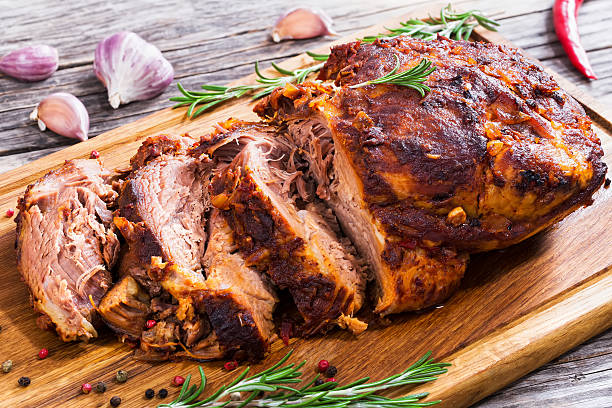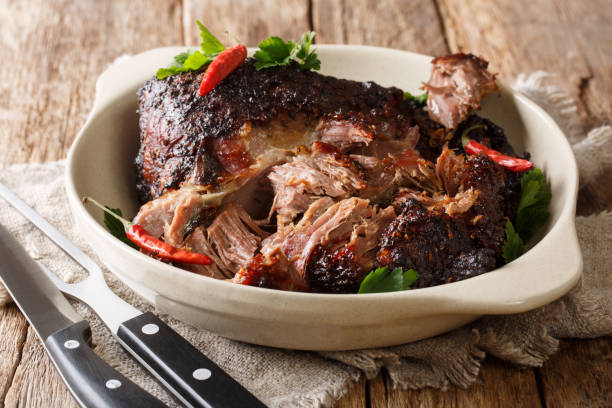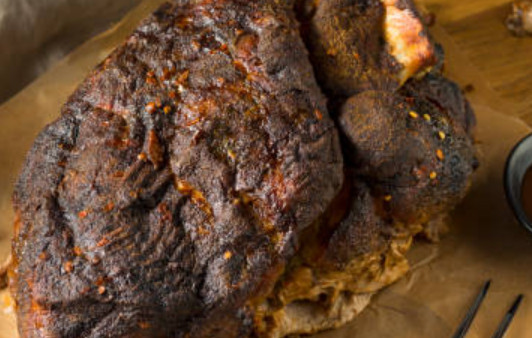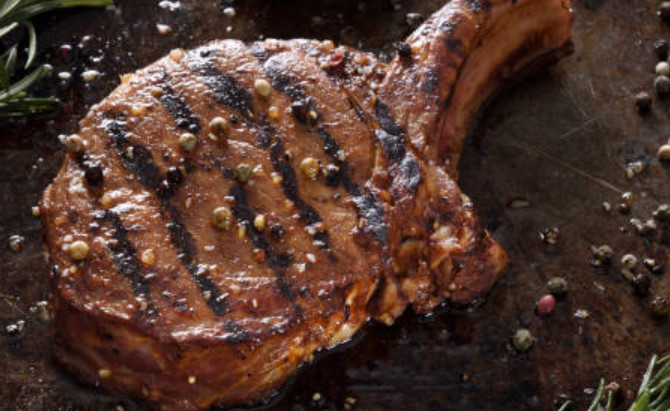How Long To Smoke A Pork Shoulder? | Easy Cooking Tips
Smoking a pork shoulder, a practice as ancient as it is revered, transforms a humble cut of meat into a succulent feast, redolent with the complex interplay of smoke, spice, and tender pork. But the path to achieving that perfect balance of flavor and tenderness is not just about patience—it’s an art honed through knowledge and practice. In our comprehensive guide, “How Long To Smoke A Pork Shoulder,” we unlock the secrets behind this time-honored cooking method, offering you a deep dive into the intricacies of smoking pork to perfection.
Our expertise is drawn from a wealth of experience, combined with a passion for exploring the nuanced variables that influence the smoking process. From selecting the right cut and preparing it with the ideal rub, to choosing the best wood for smoking and mastering temperature control, we cover every aspect to ensure your culinary journey is both enjoyable and successful.
Why does the duration of smoking matter, and how can it vary? The answer lies in understanding the delicate balance between heat, time, and smoke—a triad that, when harmonized, yields a pork shoulder so tender and flavorful, it effortlessly falls apart under the mere touch of a fork. This guide doesn’t just tell you how long to smoke a pork shoulder; it immerses you in the why and the how, ensuring you grasp the science and the soul behind every decision.
Join us as we delve into this comprehensive guide, where curiosity meets expertise. Whether you’re a seasoned pitmaster or a newcomer eager to embark on your first smoking adventure, our insights will elevate your smoking game, promising results that will not only satisfy your taste buds but also ignite a passion for the art of smoking meat. Continue reading to embark on a flavorful journey that promises to transform the ordinary into the extraordinary, one smoke-infused bite at a time.
Contents
- 1 A Brief History of Smoked Pork Shoulders
- 2 Why Smoke a Pork Shoulder?
- 3 Selecting the Best Pork for Smoking
- 4 Equipment Essentials
- 5 Smoking Safety
- 6 Preparing the Pork Shoulder
- 7 Smoking Techniques
- 8 Temperature and Time
- 9 Advanced Smoking Tips
- 10 Developing Your Signature Flavor
- 11 Storage and Leftovers
- 12 Conclusion
A Brief History of Smoked Pork Shoulders

Before modern refrigeration, smoking and curing meats were essential for preservation. Pork shoulders were one of the most commonly smoked cuts due to their large size, fat content, and rich flavor. Over time, pitmasters in different regions of the U.S. developed their own styles, spice blends, and sauces to complement the smoked pork. The Carolinas are particularly known for their pulled pork barbecue, which showcases the vinegary and mustard-based sauces of those areas. Nowadays, smoking pork shoulders is more about infusing flavor and achieving tender, fall-apart meat rather than preservation. But the basic principles remain the same.
Why Smoke a Pork Shoulder?
Pork shoulders offer several advantages that make them a top choice for smoking:
- Flavor – The fat content and marbling provide plenty of pork flavor. The meat takes on smoke very well.
- Value – Pork shoulders are inexpensive relative to other large cuts like brisket. You get a lot of meat for the money.
- Forgiving – The fat and connective tissue allow for a big margin of error in cooking times and temperatures. You’re less likely to dry it out or overcook it.
- Versatility – Pulled, chopped, sliced, or kept in large chunks – the finished pork shoulder can be served in many ways.
Selecting the Best Pork for Smoking
Pork Butt vs. Pork Shoulder
Confusingly, cuts labeled as “pork butt” or “Boston butt” actually come from the upper shoulder. Pork butt is the upper portion which contains more fat, while pork shoulder comes from the lower portion. Either works equally well for smoking, so choose based on your budget and what’s available. Opt for boneless over bone-in to shorten cooking time.
Meat Quality
Seeking out high-quality, humanely raised pork pays off in superior flavor and texture. Look for labels like Certified Humane, Animal Welfare Approved, or U.S. Department of Agriculture (USDA) Organic. Heritage breed pigs also produce flavorful pork. Choose pork that is pale pink with white fat instead of red meat which indicates the pig was stressed.
Sizing
For feeding a crowd, choose a pork shoulder between 8-10 pounds. Go smaller for just 4-6 people. You can always cook two smaller shoulders instead of one huge one for more bark (the delicious caramelized exterior).
Equipment Essentials
Types of Smokers
You’ll find pork smoked in everything from dedicated smokers to charcoal grills to pellet smokers. Charcoal and wood-fired offset smokers allow controlling the smoke level. Electric smokers offer set-it-and-forget convenience but less smoky flavor. Propane smokers impart subtle smoke. Smoking on a charcoal grill takes more effort but can produce amazing results. Whichever you use, accuracy of the temperature gauges is crucial.
Must-Have Tools
- Digital instant-read thermometer – Lets you monitor internal meat temp and smoker temp. A thermal probe version monitors temps remotely.
- Disposable foil pans – Catches drippings and makes cleanup easy.
- Oven mitts or gloves – Protect your hands from the hot meat and smoker.
- Tongs, large forks, or meat claws – Helps you handle and shred the pork.
- Spray bottle – For spritzing the pork with apple juice or other liquids.
Smoking Safety
Exercising caution will keep things safe and enjoyable:
- Never leave a smoker unattended, as conditions can quickly change.
- Position your smoker at least 10 feet from buildings or foliage. Have a fire extinguisher on hand.
- Use caution when adding more charcoal or wood, as flare-ups can occur.
- Use heat-resistant smoker mitts or gloves when handling anything hot.
- Wash hands, utensils, and surfaces after handling raw meat.
- Discard used marinades and smoking liquids. Don’t reuse them.
- Refrigerate leftovers within 2 hours of cooking.
Preparing the Pork Shoulder
Trimming
Most pork shoulders are sold untrimmed, with a layer of fat on one side. While you can smoke it untrimmed, removing the thickest parts of fat will reduce cooking time. Use a sharp boning knife to trim off pieces of fat until about 1⁄4 inch remains.
Seasoning
There are two common methods for seasoning smoked pork:
Dry brining – Rubbing the meat with salt and allowing it to rest uncovered in the fridge for up to 24 hours seasons it and improves moisture retention.
Wet brining – Submerging the pork in a saltwater solution for 8-12 hours seasons it while also helping it stay juicy. Use 1 cup salt per gallon of water.
Creating a Rub
Rubs add flavor and form a crust during smoking. Basic rib rubs contain salt, pepper, brown sugar, paprika, garlic powder, and chili powder. Get creative mixing your own spices or try recipes like a coffee rub for something unique. Apply the rub right before smoking so it doesn’t draw out moisture while resting.
Marinating
Soaking the pork in an acidic liquid before smoking adds huge flavor. Apple juice, cola, vinegar, wine, and fruit juices all work well. The sugars will caramelize into a tasty bark during smoking. Marinate for at least one hour, or up to overnight.
Smoking Techniques
Smoking uses indirect heat – the pork shouldn’t be directly over a flame. There are two methods:
- Hot smoking cooks the meat between 225-275°F using smoldering wood chips or chunks. This tenderizes the pork and renders fat while imparting flavorful smoke.
- Cold smoking keeps temps under 100°F to avoid cooking the meat. Hardwood sawdust produces smoke without heat. The pork must be cooked afterwards.
Temperature and Time
The two keys to smoked pork perfection are maintaining the smoker temperature in the target range and cooking the pork until it reaches the proper internal temperature.
Target Smoker Temperatures
- 225-250°F for most smoking
- 275°F if time is tight
- 300-325°F at the end to crisp the bark
Use a thermometer placed at pork level. Open vents for more heat; restrict them to lower the temp. Add more charcoal or wood as needed.
Internal Pork Temperature
- 155-165°F = safe to eat but still tough
- 185-205°F = pullable and tender
Use an instant read thermometer in the thickest part not touching bone. When it probes like warm butter, it’s done.
Estimated Smoking Times
- 8-10 lbs = 10-14 hours
- 5-7 lbs = 8-12 hours
- 12 lbs = 15+ hours
Times vary based on shape, temperature consistency, and stall duration. The pork hits a stall around 160°F when moisture evaporates. Temps will plateau until the stall ends. Be patient!
Advanced Smoking Tips
- Minimize opening the smoker so heat stays stable. Only spray or mop every 45-60 minutes after the first 2-3 hours.
- Place pork fat side up to self-baste. Put a disposable pan underneath to catch drippings.
- Wrapping in foil when the bark sets (around 160°F) powers through the stall faster.
- Spraying with apple juice or broth keeps the pork moist and adds flavor.
- Controlling humidity with a water pan prevents drying out. Add hot water or wood chunks as needed.
- Adjust vents to maintain steady temps. Close vents partially if temps are too high.
Developing Your Signature Flavor

Tweaking rubs, marinades, and how you employ smoke can make the end result distinctly yours.
- Rub experiments – Vary the sugar, herbs, and spices until you find a perfect balance.
- Regional inspirations – Use ingredient combos from your favorite regional barbecue style.
- Marinade+sauce blends – Mix marinades and finishing sauces to combine flavors.
- Smoke profiles – Toggle different woods during smoking for a complex essence.
Storage and Leftovers
With proper storage, you can enjoy leftovers for up to a week.
- Allow pork to cool for 30 minutes before refrigerating.
- Store in the fridge in an airtight container for 5-7 days.
- Freeze pulled pork for 2-3 months. Thaw in the fridge before using.
- Canned or jarred pulled pork keeps for a year shelf-stable. Pressure can it with broth or sauce.
- Crisp up leftover pork into carnitas, tacos, pizza, casseroles, sandwiches, omelets, and more!
Conclusion
Achieving finger-licking smoked pork shoulder requires patience but is worth the wait. With the right tools, techniques, and temperature control, your pork will be a mouthwatering hit. From the array of regional styles to the science behind smoke penetration, there’s always more to learn on your barbecue journey. So grab your favorite pig roastin’ rig and get smokin.
https://bamboowokmanvel.com/food-drink/pork/
Harmony Saunders is the CEO and founder of Bamboo Wok, a family-owned and operated Chinese restaurant that has been serving the Manvel, Rosharon, and Alvin communities for more than nine years. Our delicious dishes are made from scratch with the best ingredients, vegetables are fresh cut daily in our kitchen, and poultry is delivered every two days.
So whether you’re craving Chinese food for the family or need catering for your next event, please give us a try! We know you won’t be disappointed with our fresh, authentic Asian fare.







